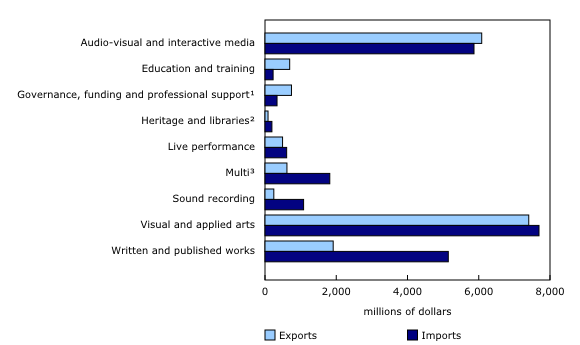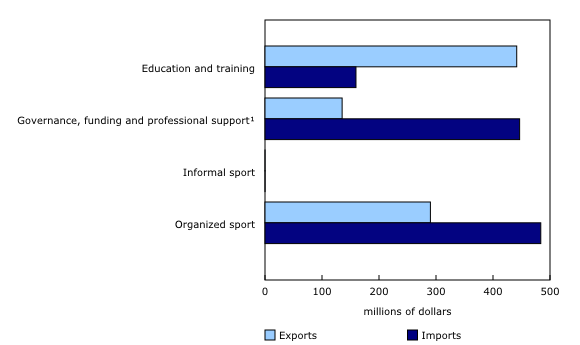Trade of culture and sport products, 2021
Released: 2023-10-10
The year 2021 saw both Canadian exports and imports of culture goods and services increase, following a turbulent year with unprecedented trade disruptions in 2020.
Total exports of culture and sport products grew 7.9% to reach $19.1 billion in 2021, representing 2.5% of Canada's total exports in the year. This growth was a reversal from the 13.5% decline in 2020.
Imports followed a similar trajectory, up 6.6% to $24.1 billion in 2021, after dropping 10.2% in 2020 when COVID-19 pandemic-related restrictions were in full effect. Imports of culture and sport products represented 3.1% of total economy imports in 2021.
Despite increases in the trade of several culture and sport products in 2021, overall, trade remained below pre-pandemic levels, with exports down 6.7% and imports down 4.3%, compared with 2019.
The trade deficit (the difference between imports and exports) widened in 2021, with Canadian imports exceeding exports of culture goods and services. The United States continued to be Canada's largest trade partner for culture and sport products.
International trade of culture products up in 2021 following unprecedented declines the year prior
Canada exported $18.3 billion of culture products in 2021, up 7.8% from the previous year, led by increased exports in the domains of visual and applied art, audio-visual and interactive media, and written and published works. At the subdomain level, crafts, broadcasting, and film and video accounted for almost three-quarters of the total culture exports in 2021. Total trade (exports and imports) of books increased in 2021 after contracting in 2020, as the industry evolved and adapted to overcome challenges presented during the pandemic—for instance, the increased use of point-of-sale software to help customers search for their favourite books online for purchase and delivery.
Meanwhile, imports increased 7.0%, reaching $23.0 billion in 2021, led by visual and applied arts, and audio-visual products. At the subdomain level, craft and broadcasting drove imports of culture products in 2021.
Overall, culture products accounted for 2.4% of all goods and services exports and 3.0% of total imports in 2021. Despite increases observed in several culture commodities, many have yet to regain their pre-pandemic status. Such was the case for trade of culture heritage and natural heritage, as well as performing arts and festivals and celebrations, which were heavily impacted by successive waves of restriction during the pandemic.
Exports of sport products rebound
Following unprecedented declines in 2020, Canadian exports of sport products increased in 2021, up 9.3%, to reach $0.9 billion. Growth was seen in all four sports subdomains, led by education and training (+$28 million), which was likely driven by the return of international students to study in Canada as pandemic restrictions eased and borders reopened in 2021.
Organized sport as well as governance, funding and professional support continued to be the most heavily traded sport products. Trade of organized sport includes tourists attending live sporting events, while governance, funding and professional support includes membership services or event support services.
Global trade of culture and sport products
The pandemic severely and abruptly impacted the trade of culture and sport goods and services by disrupting cultural activities and events. It also accelerated the shift to digital trade and online consumption, making culture more accessible globally.
The United States continued to be Canada's largest trading partner for culture and sport products. Exports to the United States represented the lion's share (70.7%) of Canada's total exports of culture and sport products in 2021.
Meanwhile, the share of Canada's imports of culture and sport products from the United States was 64.0% in 2021.
Canada's second and third largest trading partners for culture and sport products continued to be the European Union (11.1% of imports; 10.2% of exports), and then China (4.7% of imports; 3.0% of exports).
Interprovincial trade of culture and sport in 2019
Trade among the provinces continued to be pivotal to the Canadian economy. In 2019, interprovincial and inter-territorial trade in culture products amounted to $15.7 billion. Interprovincial trade (exports and imports) of culture and sport estimates are available only up to 2019. The audio-visual and interactive media domain continued to be the largest contributor to interprovincial trade, particularly in broadcasting and the film and video subdomains.
Interprovincial trade of sport products totalled $1.3 billion in 2019. Governance, funding and professional support, and organized sport led interprovincial trade of sport products.
Note to readers
The Trade of Culture and Sport Products (TCSP) provides measures of the international and interprovincial trade of goods and services attributed to both culture and sport (inclusive of the arts and heritage).
All estimates of international trade are recorded or converted to Canadian dollars using daily or monthly average exchange rates.
Culture products are goods and services produced from creative artistic activity or from the preservation of heritage.
Sport products include goods and services related to recreational sports and physical activities, and professional, semi-professional and amateur sport clubs and independent athletes that are primarily engaged in presenting sporting events before an audience. The classification excludes goods and services that are inputs for producing sport products such as equipment, but it includes merchandise sold at sporting events.
Due to data availability, interprovincial trade can be derived up until 2019 only, as it is based on the published supply and use tables.
Revisions
This release of the TCSP for reference year 2021 includes revised estimates back to 2019. However, certain revisions to the interactive media and design subdomains start in 2016. These data incorporate new and revised data, as well as updates and methodological changes stemming from the latest 2019 Provincial and Territorial Culture Satellite Account (PTCSA) and 2021 Provincial and Territorial Culture Indicators (PTCI).
Annually, estimates for the previous two years are subject to revision. These revisions allow for newly published supply and use tables, customs-based merchandise trade data and balance of payments-based trade data to be incorporated into the time series.
However, approximately every three years, the TCSP data will be revised according to revisions in the PTCSA and PTCI. This will permit new culture and sport ratios to be incorporated into the TCSP estimates.
Crafts
The crafts subdomain includes various manufactured products that originate from creative artistic activities. It includes items such as jewellery, pottery, and knives. However, because of measurement limitations, estimates of trade for the crafts subdomain may be overstated.
Film and video
The film and video subdomain underwent major enhancements starting with reference year 2015. The sources and methods for estimating this subdomain, including the Survey of Service Industries: Film, Television and Video Production Industry, have been revised to incorporate improved estimation methods. The new methodology increases the use of administrative data in combination with survey data to build the estimates. These improvements were applied to all economic variables, including trade.
Digital culture products
Technological advancements in recent years have improved the efficiency of delivery methods and consumption of services. However, this has created challenges in measuring international trade of digital services. This includes digital culture products, such as online streaming services, subscriptions, and downloads that are purchased by Canadian households directly from foreign suppliers.
Audio-visual and interactive media and visual and applied art
Refinements to the video game publishing and design and development industries, and to the computer systems design and related services industry were introduced starting in 2016 to improve estimates around video game development and website design. These impact both the design and interactive media subdomains of visual and applied arts and audio-visual and interactive media.
Users can expect significant revisions to both design and interactive media beginning in reference year 2016. There will be a noticeable break in the data series in most geographies for the interactive media and design subdomains between 2015 and 2016. This break does not represent a real change in economic conditions. Estimates prior to 2016 utilize the prior methodology and should be used with caution.
Products
The Economic accounts statistics portal, accessible from the Subjects module of the Statistics Canada website, features an up-to-date portrait of national and provincial economies and their structure.
The Latest Developments in the Canadian Economic Accounts (13-605-X) is available.
The User Guide: Canadian System of Macroeconomic Accounts (13-606-G) is available.
The Methodological Guide: Canadian System of Macroeconomic Accounts (13-607-X) is available.
Contact information
For more information, or to enquire about the concepts, methods or data quality of this release, contact us (toll-free 1-800-263-1136; 514-283-8300; infostats@statcan.gc.ca) or Media Relations (statcan.mediahotline-ligneinfomedias.statcan@statcan.gc.ca).
- Date modified:




